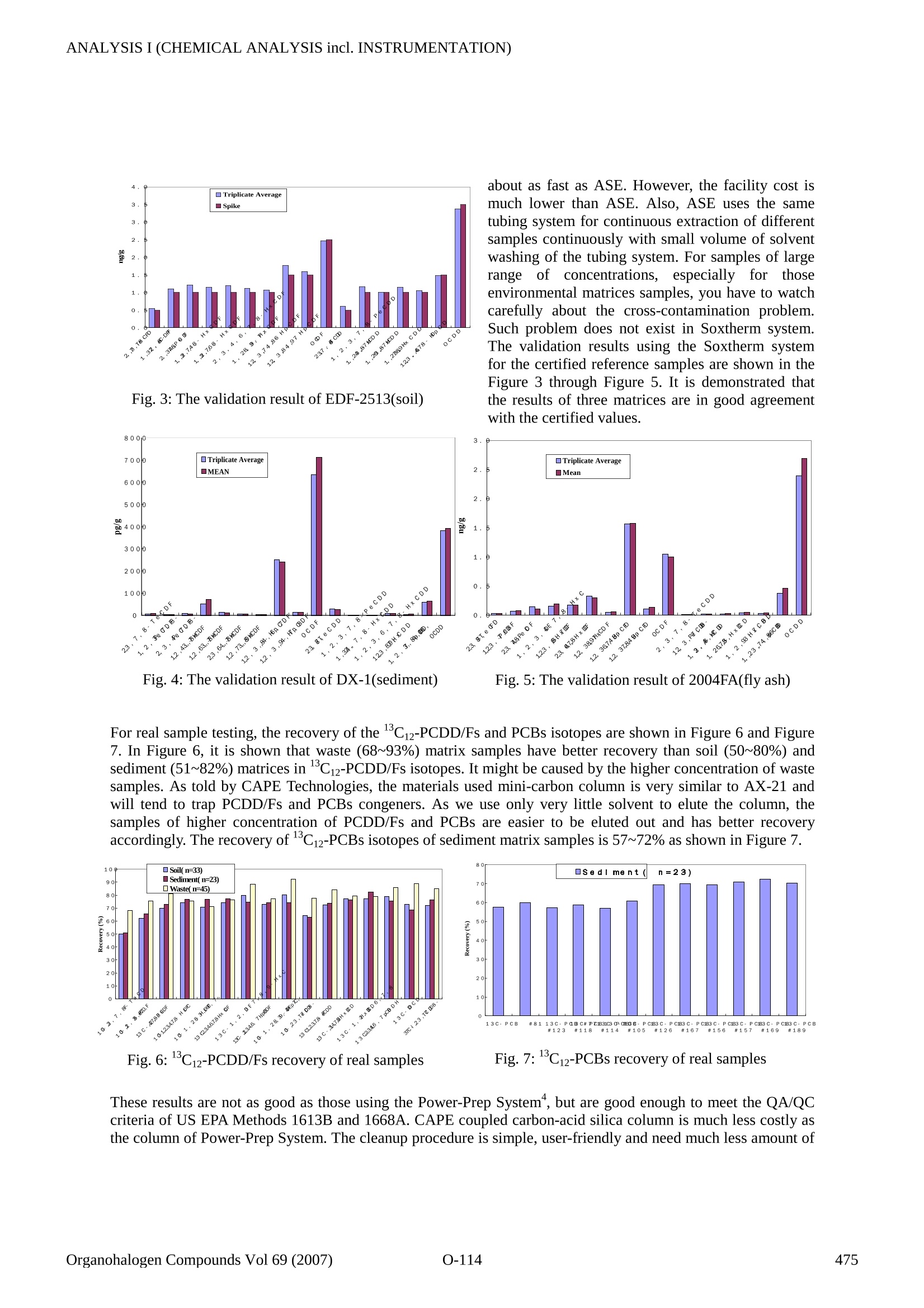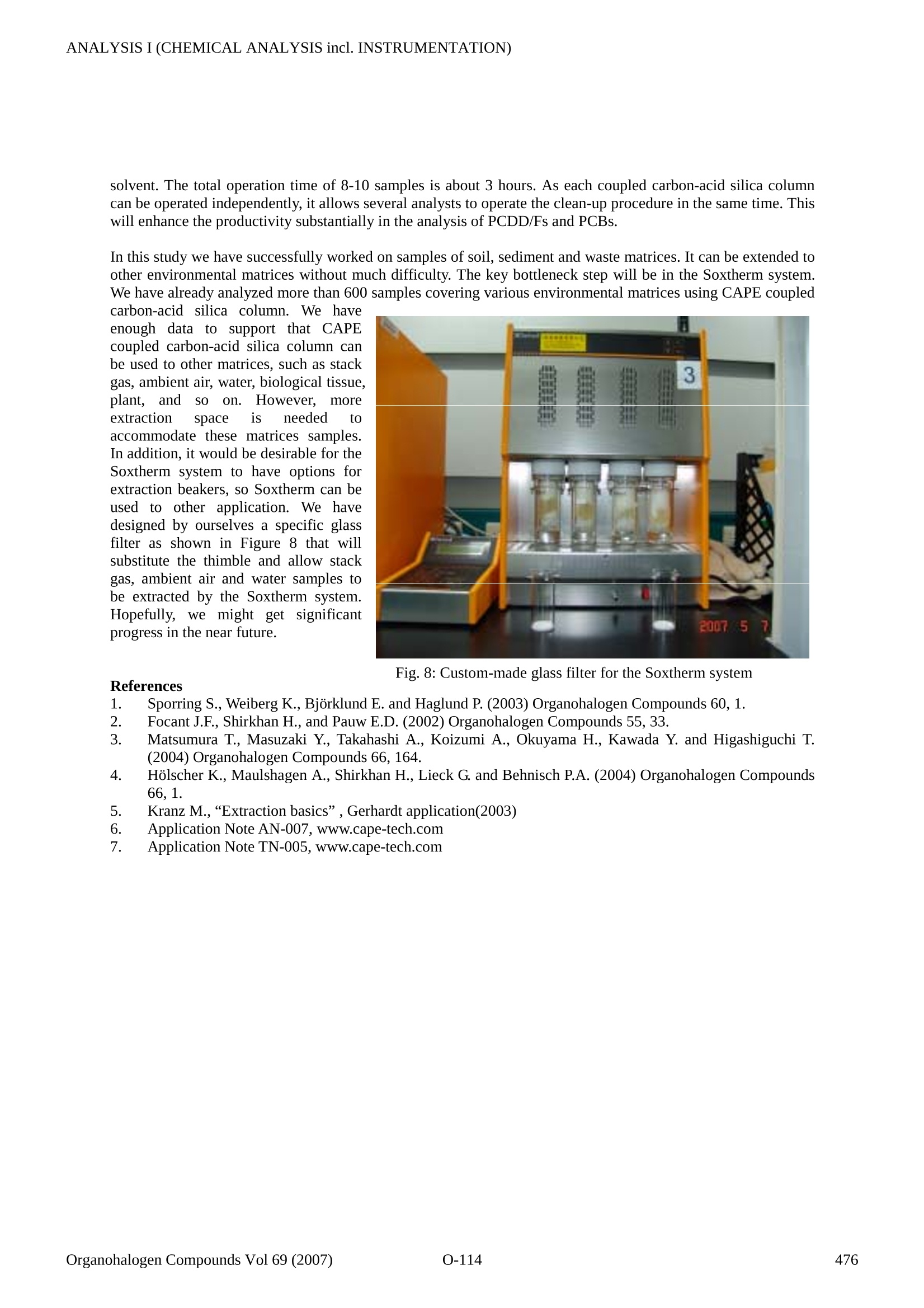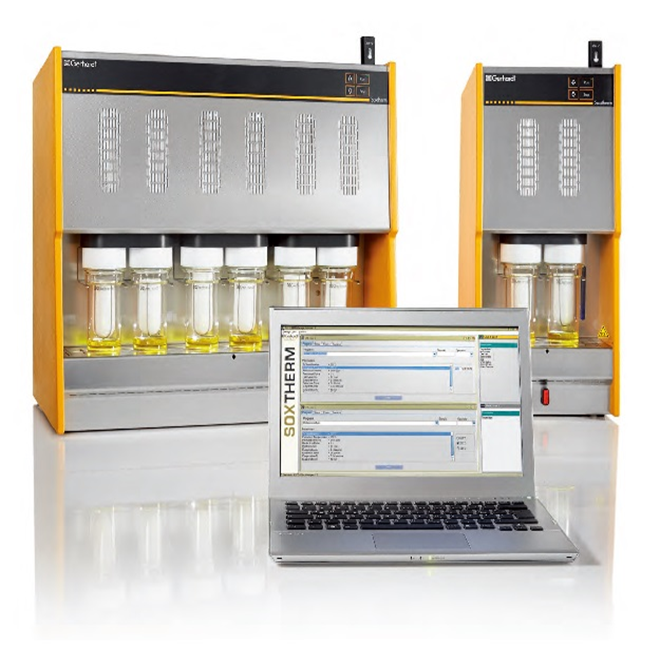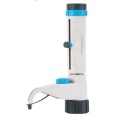方案详情
文
We use a fast and relatively cost effective method, Soxtherm with CAPE coupled carbon-acid silica column, to
improve the efficiency for the analyses of PCDD/Fs and dioxin-like PCBs in environmental samples. We choose
three kinds of certified reference samples to evaluate the Soxtherm extraction system and the results are in good
agreement with certified values. We have tested 101 real samples of different environmental matrices using this
method from 2006 to 2007. The recovery range of the 13 C 12 -PCDD/Fs is 50~93% and 13 C 12 -PCBs isotopes is
57~72%. It meets the QA/QC criteria of US EPA Methods 1613B and 1668A. We have successfully applied this
technique in samples such as soil, sediment and waste matrices and will extend it to applications in other
matrices
方案详情

ANALYSIS I (CHEMICAL ANALYSIS incl. INSTRUMENTATION) SOXTHERM WITH CAPE COUPLED CARBON-ACID SILICA COLUMNAS AMETHOD FOR FASTANALYSES OFPCDD/FS AND DIOXIN-LIKE PCBs INENVIORNMENTAL SAMPLES Chen Yuan Wu, Wu Chung Ping, Peng Ju hwa and Weng Ying Ming Environmental Analysis Laboratory (EAL), Environmental Protection Administration (EPA), Chung Li City,Taoyuan County, Taiwan 32024, R.O.C. Abstract We use a fast and relatively cost effective method, Soxtherm with CAPE coupled carbon-acid silica column, toimprove the efficiency for the analyses of PCDD/Fs and dioxin-like PCBs in environmental samples.We choosethree kinds of certified reference samples to evaluate the Soxtherm extraction system and the results are in goodagreement with certified values. We have tested 101 real samples of different environmental matrices using thismethod from 2006 to 2007. The recovery range of the 1C12-PCDD/Fs is 50~93% and ’C12-PCBs isotopes is57~72%. It meets the QA/QC criteria of US EPA Methods 1613B and 1668A. We have successfully applied thistechnique in samples such as soil, sediment and waste matrices and will extend it to applications in othermatrices. Introduction The “Belgium Crisis” in 1999 is a milestone for the analysis of dioxin-like compounds. Traditional Soxhletextraction and time-consuming cleanup procedures such as silica, alumina and carbon column were widelyadopted before that event. However, in an urgent case such as “Belgium Crisis", it is obvious that theconventional methods are not enough to deal with huge amount of samples in such short time. Recently, moreand more contamination cases involving dioxin-like compounds have caused gaUrSeat general public concern andurged government to improve response action time. Therefore, a lot of research projects using new techniquessuch as Accelerated Solvent Extraction (ASE) and Pressurized Liquid extraction (PLE)have been conducted toimprove the extraction efficiency. On the other hand, there are also research projects endeavored to shorten thetime of cleanup procedure. Automatic systems, such as Automatic Cleanup Robot’ and Power-Prep Systemwereinvolved in these tests. Though these facilities exhibit outstanding performances, the cost of these equipments isgenerally too expensive for most commercial labs to afford. Therefore, we would like to apply an alternativemethod, the Soxtherm with CAPE coupled carbon-acid silica column, which is fast and more cost-effective. Thismethod can be useful for those labs urgently needing to improve their efficiency of the analyses of PCDD/Fs anddioxin-like PCBs in environmental samples with limited budget. Materials and Methods Soxtherm extraction The extraction apparatus adopted in this study are Soxtherm SOX414 and SOX416 manufactured by Gerhardt inGermany. Soxtherm extraction is a kind of“fast Soxhlet” system. The extraction setting of each step in theSoxtherm system is listed in Table 1. Extraction procedure for the Soxtherm system is cited as 5 stages in thefollowings as illustrated in Figure 1. With this technique, the extraction time can be reduced to about 3 hours. Fig. 1: The extraction procedures of Soxtherm Item Setting Solvent/Volumn Toluene/135 mL T-classification 300℃ Extraction 270℃ Reduction Interval 6.0 min Reduction Pulse 3 sec Hot Extraction 1 h0 min Evaporation A 4 ×Interval Rinsing Time 1h30 min Evaporation B 0.0 × Interval Evaporation C 0 min Program Length 2 h 54 min CAPE coupled carbon-acid silica column The coupled carbon-acid silica column is taken fromthe Dioxin/Furan Immunoassay Kit manufactured bythe CAPE Technologies. It is originally used for abiological screening method for the USEPA Method4025°. We developed this method in our lab as abackuppmethodfor)r the screening methodDR-CALUX@tthatit We establishedm2004.Surprisingly, we found this coupled column can beapplied in the chemical confirmation method too. Inorder to get better recovery of isotope standards andmeet the QA/QC criteria of US EPA Methods 1613Band 1668A, the original cleanup procedures weremodified to the procedure as cited in the followings:Pre-clean the extract from Soxtherm extraction byacid-silica column if needed.( Add copper to removesulfur forsediment samples. ) CAPE coupledcarbon-acid silica column is set up as the picture inFigure 2. Use stopper/stopcock assembly and syringeto pressurize the column and maintain a drop-wise flow rate of 0.5-1.0mL per minute when eluted by solvent. Add 8mL n-hexane,2mL n-hexane /time x 4 times, totransfer sample extract to column. Add 15mL n-hexane to elute column. Add 15mL n-hexane to elute columnagain and start to collect all solvent passed through column for dioxin-like PCBs fraction. Remove and transfercarbon mini-column to a clean empty column. Add 6mL of 1:1 toluene: n-hexane to elute column and collect allsolvent passed through column for dioxin-like PCBs fraction. Reverse the direction of carbon mini-column. Add20mL oftoluene to elute column and collect all solvent passed through column for PCDD/Fs fraction. HRGC/HRMS The analysis of samples was performed on a HRGC (HP 6890)/ HRMS (JEOL JMS-700) using DB-5MScolumn. Validation of Soxtherm extraction We focused on the fast analyses of PCDD/Fs. Three kinds of certified reference samples, including EDF-2513 ofsoil matrix (Cambridge Isotope Laboratories), DX-1 of sediment matrix (National Water Research Institute,Canada) and 2004FA of fly ash matrix (2004 International Calibration Study, Sweden), were used to evaluateSoxtherm extraction system. The resulting data are summarized in the section of results and discussion. Real Sample Testing We have tested 101 samples of different environmental matrices using Soxtherm with CAPE coupledcarbon-acid silica column since 2006 till now. These samples include 33 soil samples, 45 waste samples (solidwaste and fly ash) and 23 sediment samples. We analyzed PCDD/Fs for soil and waste samples and analyzedboth PCDD/Fs and dioxin-like PCBs in others. Experimental results are shown in next paragraph. Results and Discussion As we can see in Table 1, the extraction time of the Soxtherm system is less than 3 hours. The samples can beextracted in parallel while ASE extracts samples in sequence. For batch extraction of 8-10 samples, Soxtherm is Fig. 3: The validation result of EDF-2513(soil) 8000 Fig. 4: The validation result of DX-1(sediment) about as fast as ASE. However, the facility cost ismuch lower than ASE. Also, ASE uses the sametubing system for continuous extraction of differentsamples continuously with small volume of solventwashing of the tubing system. For samples of largerange of concentrations, especially for thoseenvironmental matrices samples, you have to watchcarefully about the cross-contamination problem.Such problem does not exist in Soxtherm system.The validation results using the Soxtherm systemfor the certified reference samples are shown in theFigure 3 through Figure 5. It is demonstrated thatthe results of three matrices are in good agreementwith the certified values. Fig. 5: The validation result of 2004FA(fly ash) For real sample testing, the recovery of the ’C12-PCDD/Fs and PCBs isotopes are shown in Figure 6 and Figure7. In Figure 6, it is shown that waste (68~93%) matrix samples have better recovery than soil (50~80%) andsediment (51~82%) matrices in C12-PCDD/Fs isotopes. It might be caused by the higher concentration of wastesamples. As told by CAPE Technologies, the materials used mini-carbon column is very similar to AX-21 andwill tend to trap PCDD/Fs and PCBs congeners. As we use only very little solvent to elute the column, thesamples of higher concentration of PCDD/Fs and PCBs are easier to be eluted out and has better recoveryaccordingly. The recovery of C12-PCBs isotopes of sediment matrix samples is 57~72% as shown in Figure 7. Fig. 6:1’C12-PCDD/Fs recovery of real samples Fig.7:3C12-PCBs recovery of real samples These results are not as good as those using the Power-Prep System , but are good enough to meet the QA/QCcriteria of US EPA Methods 1613B and 1668A. CAPE coupled carbon-acid silica column is much less costly asthe column of Power-Prep System. The cleanup procedure is simple, user-friendly and need much less amount of solvent. The total operation time of 8-10 samples is about 3 hours. As each coupled carbon-acid silica columncan be operated independently, it allows several analysts to operate the clean-up procedure in the same time. Thiswill enhance the productivity substantially in the analysis of PCDD/Fs and PCBs. In this study we have successfully worked on samples of soil, sediment and waste matrices. It can be extended toother environmental matrices without much difficulty. The key bottleneck step will be in the Soxtherm system.We have already analyzed more than 600 samples covering various environmental matrices using CAPE coupled carbon-acid silica column. We haveenough data to support that CAPEcoupled carbon-acid silica column canbe used to other matrices, such as stackgas, ambient air, water, biological tissue,plant, andSO0on.However, moreextraction space is needed toaccommodate these matrices samples.In addition, it would be desirable for theSoxtherm system to have options forextraction beakers, so Soxtherm can beused to other application. We havedesigned by ourselves a specific glassfilter as shown in Figure 8 that willsubstitute the thimble and allow stackgas, ambient air and water samples tobe extracted by the Soxtherm system.Hopefully, we might get significantprogress in the near future. Fig. 8: Custom-made glass filter for the Soxtherm system References Sporring S., Weiberg K., Bjorklund E. and Haglund P.(2003) Organohalogen Compounds 60, 1.23 Focant J.F., Shirkhan H., and Pauw E.D. (2002) Organohalogen Compounds 55, 33. Matsumura T., Masuzaki Y., Takahashi A., Koizumi A., Okuyama H., Kawada Y. and Higashiguchi T.(2004) Organohalogen Compounds 66, 164. 4. Holscher K., Maulshagen A., Shirkhan H., Lieck G. and Behnisch P.A. (2004) Organohalogen Compounds66,1. 5Kranz M.,“Extraction basics", Gerhardt application(2003)67 Application Note AN-007, www.cape-tech.com Application Note TN-005, www.cape-tech.com Organohalogen Compounds Vol (O- We use a fast and relatively cost effective method, Soxtherm with CAPE coupled carbon-acid silica column, to improve the efficiency for the analyses of PCDD/Fs and dioxin-like PCBs in environmental samples. We choose three kinds of certified reference samples to evaluate the Soxtherm extraction system and the results are in good agreement with certified values. We have tested 101 real samples of different environmental matrices using this method from 2006 to 2007. The recovery range of the 13 C 12 -PCDD/Fs is 50~93% and 13 C 12 -PCBs isotopes is 57~72%. It meets the QA/QC criteria of US EPA Methods 1613B and 1668A. We have successfully applied this technique in samples such as soil, sediment and waste matrices and will extend it to applications in other matrices
确定




还剩2页未读,是否继续阅读?
中国格哈特为您提供《环境水中二噁英、多氯联苯PCBs检测方案(快速溶剂萃取)》,该方案主要用于环境水(除海水)中二噁英、多氯联苯PCBs检测,参考标准--,《环境水中二噁英、多氯联苯PCBs检测方案(快速溶剂萃取)》用到的仪器有格哈特全自动快速溶剂萃取仪Sox416、德国移液器MM
相关方案
更多
该厂商其他方案
更多











